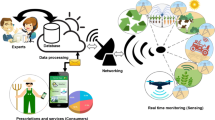Abstract
Natural disaster is one of the most important research topics worldwide. In this paper, a data driven cyber-physical system is introduced to detect landslides. This system is composed of Wi-Sun acceleration sensors, which can detect the acceleration of the nearby environment in 3D domain, and the sensors are linked with the router (act as ’sink’ node) via Wi-Sun transmission (i.e. IEEE802.15.4g). The details of the detection system are explained and the landslide detection mechanism with low computational complexity is proposed. A traffic reduction method is proposed thereafter to help reduce the data needed for transmission by exploring the intra-correlations of the sensor data. This method can save the energy consumption without degrading the detection performance. Field test is conducted and the results show that the landslide can be detected and amount of data to be transmitted can be reduced, which verifies the system’s effectiveness.













Similar content being viewed by others
Notes
Please note that the method could also be applied to other WSNs, especially which uses the same sensor
Note that other type of sensors such as video cameras [36] could be used to help reduce the false alarm, this is left as the future work.
Please note that sensors broadcast generated samples every two minutes, which is insufficient in emergency cases. Whether it is possible to use adaptive transmission rate, i.e. samples with adaptive total number to be delivered, is left as the future work. The most difficult part of the adaptive transmission frequency is the limitation of the hardware.
References
Saha S, Matsumoto M (2007) A framework for disaster management system and wsn protocol for rescue operation. In: TENCON 2007-2007 IEEE Region 10 Conference. IEEE, pp 1–4
Chen D, Liu Z, Wang L, Dou M, Chen J, Li H (2013) Natural disaster monitoring with wireless sensor networks: a case study of data-intensive applications upon low-cost scalable systems. Mob Netw Appl 18(5):651–663
Tuna G, Mumcu TV, Gulez K, Gungor V, Erturk H (2012) Unmanned aerial vehicle-aided wireless sensor network deployment system for post-disaster monitoring. In: International Conference on Intelligent Computing. Springer, pp 298–305
Ali K, Nguyen HX, Vien Q-T, Shah P (2015) Disaster management communication networks: Challenges and architecture design. In: IEEE International Conference on Pervasive Computing and Communication Workshops (PerCom Workshops), 2015. IEEE, pp 537–542
Yick J, Mukherjee B, Ghosal D (2008) Wireless sensor network survey. Comput Netw 52(12):2292–2330
Al-Karaki JN, Kamal AE (2004) Routing techniques in wireless sensor networks: a survey. IEEE Wirel Commun 11(6):6–28
Iyengar SS, Brooks RR (2016) Distributed sensor networks: sensor networking and applications. CRC press, Boca Raton
Dong M, Ota K, Liu A, Guo M (2016) Joint optimization of lifetime and transport delay under reliability constraint wireless sensor networks. IEEE Trans Parallel Distrib Syst 27(1):225–236
Wu F-J, Kao Y-F, Tseng Y-C (2011) From wireless sensor networks towards cyber physical systems. Pervasive Mobile Comput 7(4):397–413
Chang K-H, Mason B (2012) The ieee 802.15. 4g standard for smart metering utility networks. In: 2012 IEEE Third International Conference on Smart Grid Communications (SmartGridComm). IEEE, pp 476–480
Obata K, Mizutani K, Harada H (2016) Carrier frequency offset estimation scheme for ieee 802.15. 4g based wide area wi-sun systems. In: 2016 IEEE International Conference on Communications (ICC). IEEE, pp 1–6
Fadel E, Gungor V, Nassef L, Akkari N, Maik MA, Almasri S, Akyildiz IF (2015) A survey on wireless sensor networks for smart grid. Comput Commun 71:22–33
Liu X-Y, Zhu Y, Kong L, Liu C, Gu Y, Vasilakos AV, Wu M-Y (2015) Cdc: Compressive data collection for wireless sensor networks. IEEE Trans Parallel Distrib Syst 26(8):2188–2197
Gungor V, Hancke GP (2009) Industrial wireless sensor networks: Challenges, design principles, and technical approaches. IEEE Trans Ind Electron 56(10):4258–4265
Pottie GJ, Kaiser WJ (2000) Wireless integrated network sensors. Commun ACM 43(5):51–58
Alliance Z et al (2006) Zigbee specification
Feng J, Liu Z, Ji Y (2014) Wireless channel loss analysis-a case study using wifi-direct. In: Wireless Communications and Mobile Computing Conference (IWCMC), 2014 International. IEEE, pp 244–249
Castillo-Effer M, Quintela DH, Moreno W, Jordan R, Westhoff W (2004) Wireless sensor networks for flash-flood alerting. In: 2004. Proceedings of the Fifth IEEE International Caracas Conference on Devices, Circuits and Systems, vol 1. IEEE, pp 142–146
Han R, Zhao X, Yu Y, Guan Q, Hu W, Li M (2016) A cyber-physical system for girder hoisting monitoring based on smartphones. Sensors 16(7):1048
Standoli CE, Guarneri MR, Perego P, Mazzola M, Mazzola A, Andreoni G A smart wearable sensors system for counter-fighting overweight in teenagers
Tan G, Bertier M, Kermarrec A-M (2009) Visibility-graph-based shortest-path geographic routing in sensor networks. In: INFOCOM 2009 IEEE. IEEE, pp 1719–1727
Hammoudeh M, Newman R (2015) Adaptive routing in wireless sensor networks: Qos optimisation for enhanced application performance. Inf Fusion 22:3–15
Yu F, Pan S, Hu G (2015) Hole plastic scheme for geographic routing in wireless sensor networks. In: 2015 IEEE International Conference on Communications (ICC). IEEE, pp 6444–6449
Suriyachai P, Roedig U, Scott A (2012) A survey of mac protocols for mission-critical applications in wireless sensor networks. IEEE Commun Surv Tutorials 14(2):240–264
Huang P, Xiao L, Soltani S, Mutka MW, Xi N (2013) The evolution of mac protocols in wireless sensor networks: A survey. IEEE Commun Surv Tutorials 15(1):101–120
Rault T, Bouabdallah A, Challal Y (2014) Energy efficiency in wireless sensor networks: A top-down survey. Comput Netw 67:104–122
Ren J, Zhang Y, Zhang N, Zhang D, Shen X (2016) Dynamic channel access to improve energy efficiency in cognitive radio sensor networks. IEEE Trans Wirel Commun 15(5):3143–3156
Santini S, Romer K (2006) An adaptive strategy for quality-based data reduction in wireless sensor networks. In: Proceedings of the 3rd international conference on networked sensing systems (INSS 2006), pp 29–36
Luo H, Luo J, Liu Y, Das SK (2006) Adaptive data fusion for energy efficient routing in wireless sensor networks. IEEE Trans Comput 55(10):1286–1299
Zhu Y, Song E, Zhou J, You Z (2005) Optimal dimensionality reduction of sensor data in multisensor estimation fusion. IEEE Trans Signal Process 53(5):1631–1639
Msechu EJ, Giannakis GB (2012) Sensor-centric data reduction for estimation with wsns via censoring and quantization. IEEE Trans Signal Process 60(1):400–414
Liu Z, Tsuda T, Watanabe H (2015) Traffic deduction exploring sensor data’s intra-correlations in train track monitoring wsn. In: SENSORS IEEE, pp 1–4
Ryuo S, Hada A, Iwasawa N, Kawamura T, Nozue M, Kawasaki K The early detection method for embankment collapse using acceleration data, pp 517–522
Iwasawa N, Hada A, Ryuo S, Kawamura T, Nozue M, Kawasaki K (2015) The applicability for condition monitoring system in railway by using the Wi-SUN network (in Japanese), pp 1–6
Abbasi AA, Younis M (2007) A survey on clustering algorithms for wireless sensor networks. Comput Commun 30(14):2826–2841
Liu Z, Cheung G, Ji Y (2013) Optimizing distributed source coding for interactive multiview video streaming over lossy networks. IEEE Trans Circ Syst Video Technol 23(10):1781–1794
Acknowledgments
The research results have been achieved by ”Research and Development on Fundamental and Utilization Technologies for Social Big Data,” the Commissioned Research of National Institute of Information and Communications Technology (NICT), Japan.
Author information
Authors and Affiliations
Corresponding author
Rights and permissions
About this article
Cite this article
Liu, Z., Tsuda, T., Watanabe, H. et al. Data Driven Cyber-Physical System for Landslide Detection. Mobile Netw Appl 24, 991–1002 (2019). https://doi.org/10.1007/s11036-018-1031-1
Published:
Issue Date:
DOI: https://doi.org/10.1007/s11036-018-1031-1




